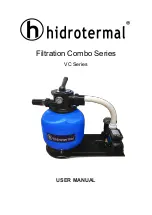
3
3 . Install the filters into the filter manifold . Make sure all plastic
wrapping and protective plastic caps have been removed from
the filters prior to their installation . To install these filters, push
them into the filter manifold and give them a quarter twist
(clockwise when viewed from below) . When the filter is
completely inserted, the cartridge label will be front centered .
4 . Anchor the system on a wall stud or suitable mounting
materialspanning wall studs . System must be vertical, upright
and level . The mounting hardware used must be selected
and installed so that the system is firmly pressed against the
mounting surface . The system mounting hardware must keep
the system from moving during routine service and operation .
5 . Run a suitable line from the tap water source to the inlet ball
valve on the left side of the system . Brace the inlet ball valve on
the system with a wrench when connecting the feed water line .
DO NOT OVERTIGHTEN CONNECTION FITTING INTO
BALL VALVE.
6 . Select the appropriate size tubing for the equipment being fed,
and connect it to the outlet ball valve of the system .
DO NOT OVERTIGHTEN CONNECTION FITTING INTO BALL
VALVE.
7 . Install the ¼" (8mm) tubing into the Quick-Connect fitting on the
outlet of the system and hold it over a drain . Open the
1
⁄
4
" (8mm)
drain valve .
8 . Once all inlet and outlet piping has been completed, check and
make sure all filter housing(s) are tight, slowly open the inlet valve
and allow all air to purge from the system through the
1
⁄
4
" tubing .
Slowly close the
1
⁄
4
" (8mm) drain valve, allow the system to reach
operating pressure, and check for leaks .
9 . If no leaks are present, open the
1
⁄
4
" (8mm) drain line again and
allow it to run to drain for 5 minutes to flush the system then
close the valve .
10 . Open the outlet water valve and check for leaks .
11 . Record the start up date and pressure gauge values in system
maintenance log .
Overtightening components can damage the system causing
water damage and/or system failure.
Maintenance
Routine maintenance of this system involves periodic filter changes .
Filter cartridges should be changed at end of filter life, due to lack of
filtering performance, or whenever a 15psi pressure drop or greater
is experienced during normal operation, whichever comes first .
Filter Cartridge Replacement Procedure
Determine whether all equipment connected to the system must
be turned off prior to shutting off water supply from filters.
1 . If required, turn off downstream equipment .
2 . Turn OFF water to the system by closing the inlet and outlet ball
valves .
3 . Open the ¼" drain valve on the outlet of the system to relieve
pressure in the housings .
4 . Remove all filters . The QT style filters are removed by rotating
them 1/4 turn to the left and then gently pulling down .
5 . Insert new QT style filters into the manifold assembly . Push up
and twist each QT cartridge 1/4 turn to the right to properly
install it into the manifold assembly . When making the 1/4 turn,
the cartridge label should come to a stop facing you .
Replacement Parts
Description
Ordering Code
Filter Head 3/8" Top In/Out Quick Connect HSR-QTHD-QC38
Filter Head 3/8" Side In/Out FNPT
HSR-QTHD-TT38
Manifold Head First Stage With NPT Inlet
HSR-QTMHF-NPT
Manifold Head Last Stage
HSR-QTMHL
Ball Valve 3/8 NPT
HSR-BV3/8
Ball Valve 1/4 NPT Plastic
HSR-BV1/4P
Ball Valve 1/4 NPT Brass
HSR-BV1/4PLH
Ball Valve 1/2 NPT
HSR-BV1/2
Outlet Back Mount Pressure Gauge
HSR-GAUGE-BKM
Do not overtighten filter housing, overtightening may damage
O-ring(s), cause water leaks, or affect system performance.
6 . Slightly open the inlet ball valve and fully open the ¼" drain
valve . Once full flow of water flows from the drain port, slowly
open the inlet valve to the full open position . Allow water to flush
to drain for 5 minutes .
7 . Slowly close the drain valve and check the system for leaks .
8 . Slowly open the outlet valve to restore water flow to downstream
equipment .
9 . Record filter change date in system maintenance log .
Teflon
®
is a registered trademark of E .I . DuPont de Nemours & Company .
NOTICE
NOTICE
WARNING
!
NOTICE
QTBRWMAX-1S-1M
18.75
10.03
5.56
10.03
18.75
5.56
Allow 3
"
(76mm) of clearance at bottom of system for removal
of filter bowls for filter cartridge replacement
NOTICE
QTBRWMAX-2S-1M
20.39
14.69
5.56
14.69
20.39
5.56






















